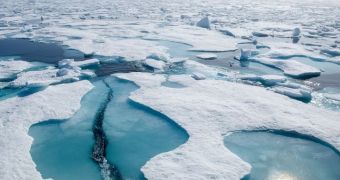Sea ice might think that nothing can touch it while it is busy splashing around in the ocean but, as it turns out, this is not the case. On the contrary, there is something that sea ice should be very much afraid of, and this something is giant waves.
A study whose findings have recently been published in the journal Nature shows that, when they hit sea ice floating about on the surface, waves that are higher than 3 meters (about 9.8 feet) can cause impressive damage.
More precisely, evidence obtained with the help of sensors indicates that such freak waves pack such a punch that they can cause the sea ice they chance to stumble upon to fracture at distances of hundreds of miles from its edge, Phys Org informs.
Thus, it appears that, whereas small waves become weaker over distance, giant waves pack enough strength to begin with to be able to move through sea ice over considerable distances and fracture it. Besides, they are not hindered by ice floes.
“Storm-generated ocean waves propagating through Antarctic sea ice are able to transport enough energy to break sea ice hundreds of kilometers from the ice edge,” the scientists who have worked on this research project write in the journal Nature.
This means that, all things considered, giant storm waves influence sea ice breakup and retreat to a greater extent than previously believed. As detailed in Nature, “This implies a more prominent role for large ocean waves in sea-ice breakup and retreat than previously thought.”
Given the fact that, when fractured, sea ice can more easily travel to warmer waters and melt, specialists believe that these findings might help explain changes in polar sea ice levels. Thus, it is argued that an increase in the number and intensity of storms in the ocean need be linked to sea ice loss.
The good news is that, unlike ice shelves, which sit on land and which threaten to cause sea level rise should they come to melt, sea ice is already found in the water. This means that, even if giant waves break it and cause it to disappear, sea ice is highly unlikely to endanger coastal regions.
“Sea ice melts and grows annually and is unrelated to sea-level rise. Sea ice is sometimes confused with ice shelves, which are related to sea level rise,” study author Alison Kohout with the National Institute of Water and Atmospheric Research in Christchurch, New Zealand tells Live Science in a recent interview.

 14 DAY TRIAL //
14 DAY TRIAL //